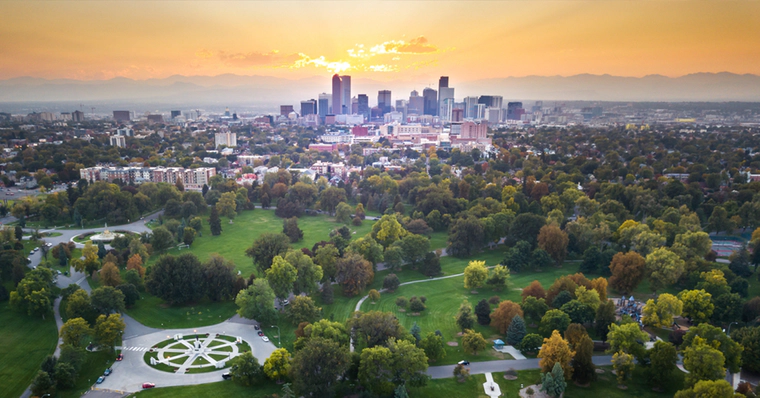Drug Abuse and Drug Rehab in Denver, Colorado

Denver, the mile-high city, has a population of 716,000 people. Large suburbs surround Denver on every side, bringing the metropolitan area population to more than three million.
As the major metro area in one of the first two states to legalize both medical and recreational marijuana, perhaps it is not surprising that Denver has more pot shops than Starbucks. In the whole state, there are three times as many weed outlets as Starbucks storefronts.1
Therefore, it might not be surprising that more than one in four people in the state used marijuana in the last year. Among those aged 18 to 25, it’s even higher—almost every second person.2 These numbers are significantly higher than the national average.
While Denver and Colorado are somewhat famous for their marijuana trade, that’s far from the only drug causing problems in the region. Lying at the intersection of Interstate 70 and Interstate 25, Denver is a crossroads for any foreign or domestic drug trafficking organization that wishes to move its products.
In 2021, Colorado’s police seized enough fentanyl to kill the entire population of the state six times over.3 It only takes two milligrams of fentanyl to kill a person who’s new to the drug and 151 pounds of fentanyl were seized that year. In July 2022, Colorado law enforcement further announced the seizure of 200,000 illicitly-manufactured pills containing fentanyl, along with more than nine pounds of heroin and a pound of cocaine.4
While these drug dealers and traffickers were taken off the street, the problem is that there is always someone willing to replace the ones that were arrested. While law enforcement does its job, there must be many others working diligently and effectively to help those who are addicted leave their destructive habits behind.
Families Seeking Drug Rehab
As soon as a family identifies an addiction problem in a loved one, it’s vital that they begin the decision-making process to find a drug rehab for this individual. The problem is that many families miss the fact that their loved one is addicted to drugs, alcohol or both. This can go on for months or even years. This can happen because an addicted person normally goes to great pains to conceal their addiction.
How do they hide their drug consumption? They only use drugs when they are away from a person they know will disapprove. They will hide their supplies or paraphernalia. They change their friends to ones who will not criticize their drug use. They will plan their days and events around being able to consume the drugs they need, when they need them and when there is no one around to stop them. They try never to visit their families when they are noticeably high.

Even the most honest person suffers degradation of their self-esteem and integrity when drugs control their thoughts and habits. For this reason, it’s more often the family that reaches out to convince the individual that they need help rather than the addicted person themselves asking for rehab.
Therefore the family must review the drug rehab facilities available to them and make a decision about which one is right for their situation. The choice depends on the existing abilities, life skills and willingness of the addicted person.
Finding the Best Type of Program
Many people starting out in drug rehab will fight the process for a significant period of time. This person is likely to do best in a residential rehab program that they will live in until they complete the program. In this program, the person is surrounded by support and resources. Someone not fully committed or willing to get sober can still make it if they can find an effective, residential inpatient rehab program.
An individual who is willing and who also has good support in the form of family and friends they can turn to may succeed in an outpatient drug rehab facility. In this program, the person will have a strict schedule of counseling, meetings and life skills training to attend but they reside at home. It’s a part-time program that also enables them to work or care for children if they need to.
There are plenty of non-profit, charitable or community programs that can help as well. These take the form of twelve-step programs for alcohol or narcotics, support groups, halfway houses and organizations called therapeutic communities (TCs). In a TC, those in recovery provide supervision and structure for others in recovery. Some TCs require members to take jobs inside or outside of the group. All rules must be strictly followed for a person to stay in the TC.
Relying on drugs or alcohol is a tremendously difficult habit to break and the vast majority of people starting new sober lives need plenty of support. That support may be professional or familial, or it may come from others who have been through the same struggle.
Treatment Admissions

A 2020 report noted that the Denver metropolitan area saw increased treatment admissions for five types of drug addiction: alcohol, marijuana, methamphetamine, heroin and prescription opioids. One only category had a decline: cocaine.5 Those seeking help for alcoholism had been trapped in their addiction for an average of 23 years before they were admitted to treatment. Those entering treatment for cocaine addiction had been using this drug for an average of 16 years before admission and for heroin, it was 9 years.
These are tremendously long periods of time to spend addicted. Especially in today’s environment with fentanyl contaminating so many different types of drugs, every incident of drug use can be life-threatening.
Out of every 100,000 people in Colorado, 234 of them are admitted to drug rehab services for alcoholism. Another 110 per 100,000 are admitted for heroin addiction and 96 for methamphetamine addiction. Marijuana follows at 79 people per 100,000 population.5
What drugs are taking the most lives in this area? In Denver, opioid drugs killed the most number of people. Deaths from heroin were small in comparison, and fentanyl made up the remainder. Three categories—total overdose deaths, opioid overdoses and fentanyl overdoses—all saw large increases in 2020 over the prior years. Methamphetamine deaths were also up both in Denver and the state.5
Finding Drug Rehab in Denver
Unlike some other cities, Denver has scores of drug rehab facilities, according to the Substance Abuse and Mental Health Services Administration. The surrounding area has scores more. There is no shortage of drug rehabilitation facilities to help those who are caught in this trap. And there is no time to waste when someone needs help recovering their sobriety and safety.
Sources:
-
Business Insider. “Denver has twice as many pot dispensaries as Starbucks.” Business Insider, 2016. Business Insider. ↩︎
-
SAMHSA. “2019-2020 National Survey on Drug Use and Health: Model-Based Prevalence Estimates.” Substance Abuse and Mental Health Services Administration, 2021. SAMHSA. ↩︎
-
Fox31. “Colorado State Patrol seized 5 times more fentanyl in 2021 than 2020.” Fox 31, 2022. Fox31. ↩︎
-
Colorado Public Radio. “200,000 fentanyl pills seized in what Colorado law enforcement considers life-saving busts.” CPR, 2022. CPR. ↩︎
-
Colorado Substance Abuse Trend and Response Task Force. “Annual Report, 2021.” Colorado Attorney General, 2021. COAG. ↩︎ ↩︎ ↩︎
